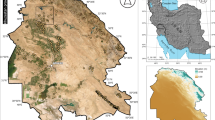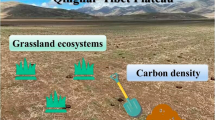Abstract
Urban soils, although crucial to defining urban vegetation types and strengthening the resilience of urban ecosystems, can be severely modified by human activities. Yet understanding of these modifications and their implications for soil properties is limited. This study examined the vertical and spatial variability of selected soil physicochemical properties (pH, SOM, OC, TN, and bulk density) in Kumasi, Ghana, using a stratified random sampling technique. Soil samples were collected at three depths (0–15, 15–30, and 30–60 cm) from 161 plots in eight green space types within two urban zones. Mean topsoil pH ranged between 5.0 in the natural forest and 6.5 in home gardens. Mean bulk density, nitrogen, and carbon concentrations differed among green space types and depths (p < 0.0001). Soil nitrogen and carbon concentrations in the 0–15 cm depth were two times greater than those of the 30–60 cm depth. Soil pH and organic matter concentrations were higher in the core urban soils than in the peri-urban while the reverse was true for total soil N and bulk density. Canonical discriminant analysis showed considerable separation of green space types based on the soil physicochemical properties. Higher total nitrogen and C:N ratios separated natural forest and cemetery from the other UGS types, whereas higher pH and bulk densities separated plantations and home gardens from the rest of the UGS types. Furthermore, the subsoil layers were laden with undecomposed cloths, plastics, concrete, and metal parts which can obstruct root growth and water movement. Results generally demonstrate considerable variability in soil properties among urban green spaces and highlight the need for a better understanding of these patterns to ensure continued support for plant growth, green space sustenance and maintenance, and the ecosystem services derived from them.






Similar content being viewed by others
References
Agboadoh MDY (2011) Estimation and mapping of soil organic carbon stocks in croplands of the bechem forest district, Ghana. Kwame Nkrumah University of Science and Technology and University of Twente
Bationo A, Kihara J, Vanlauwe B, Waswa B, Kimetu J (2006) Soil organic carbon dynamics, functions and management in West African agro-ecosystems. https://doi.org/10.1016/j.agsy.2005.08.011
Batjes NH (1996) Total carbon and nitrogen in soils of the world. Eur J Soil Sci 47:151–163
Bockheim JG (1974) Nature and properties of highly disturbed soils. In: Division S5, soil science society of America. Philadelphia, Pensylvania
Brahene SW (2013) Dynamics of soil carbon sequestration under oil palm plantations of different ages. University of Ghana
Bremner JM (1960) Determination of nitrogen in soil by the Kjeldahl method. J Agric Sci 55:11–33
Capra GF, Vacca S, Cabula E, Grilli E, Buondonno A (2012) Human-altered and human-transported soils in an Italian industrial district. Soil Sci Soc Am J 76:1828. https://doi.org/10.2136/sssaj2011.0384
Capra GF, Ganga A, Grilli E, Vacca S, Buondonno A (2015) A review on anthropogenic soils from a worldwide perspective. J Soils Sedim 15:1602–1618. https://doi.org/10.1007/s11368-015-1110-x
Coulter LL, Stow DA, Tsai Y, Ibanez N, Shih H, Kerr A, Benza M, Weeks JR, Mensah F (2016) Remote sensing of environment classification and assessment of land cover and land use change in southern ghana using dense stacks of landsat 7 ETM + imagery. Remote Sens Environ 184:396–409. https://doi.org/10.1016/j.rse.2016.07.016
Craul PJ (1985) A descrription of urban soils and their desired properties. J Arboric 11:330–339
Drechsel P, Keraita B (2014) Irrigated urban vegetable production in Ghana: characteristics, benefits, and risk mitigation, 2nd edn. Int Water Manag Inst, Colombo
European Commission (EU) (2013) Soil Atlas of Africa, Soil Atlas of Africa. https://doi.org/10.2788/52319
FAO (2010) Global forest resource assessment 2010. Rome. https://doi.org/10.1017/CBO9781107415324.004
Galbraith J (2017) Human-altered and human-transported soils. In: USDA (ed) Soil survey manual. USDA, pp 525–554
Ghana Statistical Service G (2012) 2010 population and housing census final results Ghana statistical service
Halm AT, Dartey K (1991) Efficient fertilizer use for increased crop production: the Ghana experience. In: Mokwunye U (ed) Alleviating soil fertility constraints to increase crop production in West Africa. Kluwer Academic Publishers, Dordrecht, pp 139–147
Hulisz P, Charzynski P, Greinert A (2016) Urban soil resources of medium-sized cities in Poland: a comparative case study of Torun and Zielona Gora. J Soils Sedim. https://doi.org/10.1007/s11368-016-1596-x
Jim CY (1998) Urban soil characteristics and limitations for landscape planting in Hong Kong. Landsc Urban Plan 40:235–249
K.M.A. (2013) The composite budget of the Kumasi Metropolitan Assembly (KMA) for the 2013 fiscal year, Kumasi
Manu A, Twumasi YA, Coleman TL (2006) Is it the result of global warming or urbanization? The rise in air temperature in two cities in Ghana is it the result of global warming or urbanization? The rise in air temperature in two cities in Ghana. In: 5th FIG Regional Conference
Materechera SA (2016) Soil properties and subsoil constraints of urban and peri-urban agriculture within Mahikeng city in the North West Province (South Africa). J Soils Sedim. https://doi.org/10.1007/s11368-016-1569-0
Moffatt SF, McLachlan SM, Kenkel NC (2004) Impacts of land use on riparian forest along an Urban-Rural gradient in southern Manitoba. Plant Ecol 174:119–135
Nero BF (2017a) Urban green spaces enhance carbon sequestration and conserve biodiversity in cities of the Global South: case of Kumasi. University of Bonn, Ghana
Nero BF (2017b) Urban green space dynamics and socio- environmental inequity: multi-resolution and spatiotemporal data analysis of Kumasi, Ghana. Int J Remote Sens 38:6993–7020. https://doi.org/10.1080/01431161.2017.1370152
Nero BF, Campion BB, Agbo N, Callo-Concha D, Denich M (2017) Tree and trait diversity, species coexistence, and diversity- functional relations of green spaces in Kumasi, Ghana. Procedia Eng 198:99–115. https://doi.org/10.1016/j.proeng.2017.07.164
Obiri-Nyarko F (2012) Ameliorating soil acidity in Ghana: a concise review of approaches. ARPN J Sci Technol 2:143–153
Obuobie E, Keraita B, Danso G, Amoah P, Cofie OO, Raschid-sally L, Drechsel P (2006) Irrigated urban vegetable production in ghana production in Ghana. IWMI, Accra
Owusu K (2009) Changing rainfall climatology of West Africa implications for rainfed agriculture in Ghana and water sharing in the volta basin. University of Florida, Florida
Pavao-zuckerman MA (2008) The nature of urban soils and their role in ecological restoration in cities. Restor Ecol 16:642–649. https://doi.org/10.1111/j.1526-100X.2008.00486.x
Pouyat RV, Yesilonis ID, Nowak DJ (2006) Carbon storage by urban soils in the United States. J Environ Qual 35:1566–1575. https://doi.org/10.2134/Jeq2005.0215
Pouyat RV, Yesilonis ID, Russell-Anelli J, Neerchal NK (2007) Soil chemical and physical properties that differentiate urban land-use and cover types. Soil Sci Soc Am J 71:1010–1019. https://doi.org/10.2136/sssaj2006.0164
Pouyat RV, Yesilonis ID, Groffman PM (2010) Characteristics of urban soils. In: Aitkenhead-Peterson J, Volder A (eds) Urban ecosystem ecology. American Society of Agronomy Inc, Baltimore. https://doi.org/10.2134/agronmonogr55.c7
Richter D, Yaalon DH (2012) The changing model of soil. Revisit Soil Sci Soc Am J 76:766–778. https://doi.org/10.2136/sssaj2011.0407
SAS Institute (2013) SAS/STAT 13.1 User’s guide. The CANDISC Procedure. In: SAS Online Doc Version 8. pp 1897–1924
SAS Institute Inc (2008) SAS/STAT 92 User’s guide. SAS Institute Inc, Cary
Scharenbroch BC, Lloyd JE, Johnson-maynard JL (2005) Distinguishing urban soils with physical, chemical, and biological properties. Pedobiologia (Jena) 49:283–296. https://doi.org/10.1016/j.pedobi.2004.12.002
United Nations (2014) World urbanization prospects. United Nations, New York
USDA (2017) Soil survey manual, 3rd edn. USDA, United States Department of Agriculture
Wang X, Wang J, Zhang J (2012) Comparisons of three methods for organic and inorganic carbon in calcareous soils of northwestern China. PLoS ONE. https://doi.org/10.1371/journal.pone.0044334
Acknowledgements
Funding for this project was provided by Foundation Fiat Panis and the Federal Ministry of Economic Corporation via the German Academic Exchange Service. Special thanks to Drs. N. Agbo and B. Campion of the Kwame Nkrumah University of Science and Technology for their useful advice and releasing some of their students to assist with data collection. The authors are also grateful to all the people who assisted with field data collection and laboratory analysis and to the reviewers for their constructive comments.
Author information
Authors and Affiliations
Corresponding author
Rights and permissions
About this article
Cite this article
Nero, B.F., Anning, A.K. Variations in soil characteristics among urban green spaces in Kumasi, Ghana. Environ Earth Sci 77, 317 (2018). https://doi.org/10.1007/s12665-018-7441-3
Received:
Accepted:
Published:
DOI: https://doi.org/10.1007/s12665-018-7441-3




